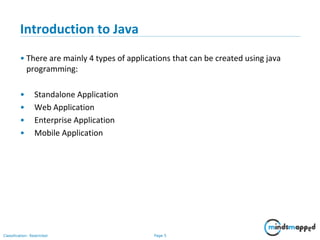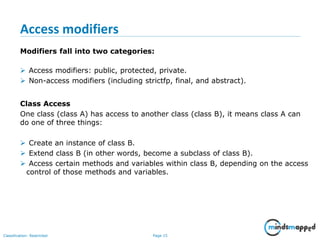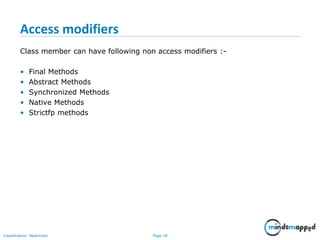Introduction to Java Part-3
- 1. Java/J2EE Programming Training Introduction to Java
- 2. Page 1Classification: Restricted Agenda • Introduction to java platform • Java virtual machine • First java program • Class declaration • Object • Legal identifiers • Declaring primitives and primitive ranges • Java Keywords • Access modifiers
- 3. Page 2Classification: Restricted Introduction to java platform • Java is a high level, robust, secured and object-oriented programming language. • Any hardware or software environment in which a program runs, is known as a platform. Since Java has its own runtime environment (JRE) and API, it is called platform. • Java is a programming language created by James Gosling from Sun Microsystems (Sun) in 1991. The target of Java is to write a program once and then run this program on multiple operating systems. • The first publicly available version of Java (Java 1.0) was released in 1995. Sun Microsystems was acquired by the Oracle Corporation in 2010. • Over time new enhanced versions of Java have been released. The current version of Java is Java 1.8 which is also known as Java 8.
- 4. Page 3Classification: Restricted Introduction to java platform
- 5. Page 4Classification: Restricted Introduction to java platform • The java program saved as .java file • Using the java compiler the code is converted into an intermediate code called the bytecode. The output is a .class file. • This code is not understood by any platform, but only a virtual platform called the Java Virtual Machine • This Virtual Machine resides in the RAM of your operating system. When the Virtual Machine is fed with this bytecode, it identifies the platform it is working on and converts the bytecode into the native machine code • Code once compiled can run not only on all PC platforms but also mobiles or other electronic gadgets supporting java. Hence, java is a language as well as a platform (JVM)
- 6. Page 5Classification: Restricted Introduction to Java • There are mainly 4 types of applications that can be created using java programming: • Standalone Application • Web Application • Enterprise Application • Mobile Application
- 7. Page 6Classification: Restricted Java virtual machine • JVM stands for Java Virtual Machine. It is the engine that drives the Java Code. It converts Java bytecode into machines language. • In other programming language, the compiler produces code for a particular system. But Java compiler produces code for a Virtual Machine. • In JVM, Java code is compiled into bytecode. This bytecode gets interpreted on different machines • JVM is responsible for allocating a memory space.
- 8. Page 7Classification: Restricted First Java program
- 9. Page 8Classification: Restricted Class declaration • A class is an entity that determines how an object will behave and what the object will contain. In other words, it is a blueprint or a set of instruction to build a specific type of object.
- 10. Page 9Classification: Restricted Class declaration • There can be only one public class per source code file. • If the class is part of a package, the package statement must be the first line in the source code file, before any import statements that may be present. • If there are import statements, they must go between the package statement (if there is one) and the class declaration. • import and package statements apply to all classes within a source code file. In other words, there's no way to declare multiple classes in a file and have them in different packages, or use different imports. • A file can have more than one nonpublic class. • Files with no public classes can have a name that does not match any of the classes in the file.
- 11. Page 10Classification: Restricted Class declaration Class
- 12. Page 11Classification: Restricted Object • Real-world objects share two characteristics: They all have state and behavior. Dogs have state (name, color, breed, hungry) and behavior (barking, fetching, wagging tail). • Software objects are conceptually similar to real-world objects: they too consist of state and related behavior. An object stores its state in fields (variables in some programming languages) and exposes its behavior through methods (functions in some programming languages). • An object is nothing but a self-contained component which consists of methods and properties to make a particular type of data useful. Object determines the behavior of the class. When you send a message to an object, you are asking the object to invoke or execute one of its methods. • An object is a specimen of a class. Software objects are often used to model real-world objects you find in everyday life.
- 13. Page 12Classification: Restricted Legal identifiers • Identifiers must start with a letter, a currency character ($), or a connecting character such as the underscore ( _ ). Identifiers cannot start with a number! • After the first character, identifiers can contain any combination of letters, currency characters, connecting characters, or numbers. • In practice, there is no limit to the number of characters an identifier can contain. • Identifiers in Java are case-sensitive; foo and FOO are two different identifier. • Exercise:- • int :b; • int -d; • int e#; I • nt .f; • int 7g;
- 14. Page 13Classification: Restricted Declaring primitives and primitive ranges
- 15. Page 14Classification: Restricted Java Keywords
- 16. Page 15Classification: Restricted Access modifiers Modifiers fall into two categories: Access modifiers: public, protected, private. Non-access modifiers (including strictfp, final, and abstract). Class Access One class (class A) has access to another class (class B), it means class A can do one of three things: Create an instance of class B. Extend class B (in other words, become a subclass of class B). Access certain methods and variables within class B, depending on the access control of those methods and variables.
- 17. Page 16Classification: Restricted Access modifiers Class access can have following access modifiers :- • Default Access • Public Access Class access can have following non access modifiers :- • Final Classes • Abstract Classes • Strictfp Classes
- 18. Page 17Classification: Restricted Access modifiers Class member can have following access modifiers :-
- 19. Page 18Classification: Restricted Access modifiers Class member can have following non access modifiers :- • Final Methods • Abstract Methods • Synchronized Methods • Native Methods • Strictfp methods



















